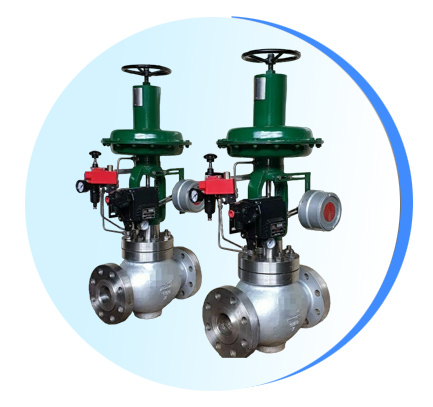
Pawar Industries is leading Manufacturers in Two-way Global Control Valves
Two-way global control valves are essential components used in industrial applications to regulate and control the flow of fluids or gases. These valves offer versatile flow control, precise regulation, and reliable performance, making them suitable for a wide range of control applications. In this comprehensive guide, we will explore the working principles, advantages, applications, and maintenance considerations of two-way global control valves. Whether you are an engineer, technician, or someone interested in fluid control systems, this article will provide valuable insights into the functionality and benefits of two-way global control valves.
Working Principles of Two-Way Global Control Valves -
Two-way global control valves operate based on a globe-shaped valve body with a movable plug or disc that controls the flow of fluids or gases. These valves consist of a valve body, a plug or disc, a stem, and an actuator mechanism.
When the valve is actuated, the plug or disc moves within the valve body, modulating the flow through the valve ports. This allows precise control over the flow rate, pressure, or temperature within the system. The globe-shaped valve body design provides a balanced flow path, ensuring stable and accurate control.
Two-way global control valves offer advantages such as versatile flow control, precise regulation, and reliable performance. They are suitable for applications that require accurate control over process variables, such as flow rate, pressure, or temperature.
Advantages of Two-Way Global Control Valves -
Two-way global control valves offer numerous advantages, making them a preferred choice in industrial applications that require versatile flow control and precise regulation. Some key advantages include:
a) Versatile Flow Control : Two-way global control valves provide versatile flow control capabilities, allowing for precise regulation and control of fluid or gas flows in various applications. They offer flexibility in adjusting flow rates, pressures, or temperatures to meet specific process requirements.
b) Precise Regulation : These valves enable accurate and precise regulation of process variables, such as flow rate, pressure, or temperature. They provide stable control over fluid or gas flows, ensuring optimal process performance and product quality.
c) Reliable Performance : Two-way global control valves are designed for reliable performance, providing secure shut-off and precise flow control even in demanding environments. Their sturdy construction and high-quality materials ensure consistent operation and longevity.
d) Versatility in Application : These valves find applications across various industries, including chemical processing, oil and gas, power generation, water treatment, HVAC systems, and more. They can handle a wide range of fluids, pressures, temperatures, and flow rates, making them suitable for diverse control applications.
e) Control System Integration : Two-way global control valves can be easily integrated into a control system, allowing for remote or automated control. Integration with control systems enables precise and responsive flow regulation, enhancing overall process automation and efficiency.
Applications of Two-Way Global Control Valves -
Two-way global control valves find applications in diverse industries where versatile flow control and precise regulation are critical. Some common applications include:
a) Chemical Processing : Two-way global control valves are extensively used in chemical processing plants for precise control over fluid flows in various processes, such as mixing, blending, or reaction control. They ensure accurate control over chemical reactions, temperature control, and composition adjustments.
b) Oil and Gas Industry : These valves play a crucial role in the oil and gas industry for controlling the flow of fluids, such as hydrocarbons, gases, or chemicals. They provide precise control over process variables, ensuring efficient and safe operations in upstream, midstream, and downstream processes.
c) Power Generation : Two-way global control valves are employed in power plants for controlling the flow of steam, condensate,or cooling water. They enable precise control over process parameters, such as temperature or pressure, ensuring optimal power generation efficiency and system reliability.
d) Water and Wastewater Treatment : These valves find applications in water and wastewater treatment plants for controlling the flow of liquids, chemicals, or sludge. They ensure accurate control over dosing, mixing, or process flows, contributing to efficient treatment processes and compliance with regulatory standards.
e) HVAC Systems : Two-way global control valves are utilized in heating, ventilation, and air conditioning (HVAC) systems for controlling the flow of heating or cooling fluids. They enable precise temperature control, energy efficiency, and comfort in residential, commercial, or industrial buildings.
f) Pharmaceutical Industry : These valves play a critical role in the pharmaceutical industry for precise control over fluid flows in processes such as ingredient dosing, formulation, or sterilization. They ensure accurate control over critical process variables, maintaining product quality and regulatory compliance.
Maintenance Considerations for Two-Way Global Control Valves -
Proper maintenance of two-way global control valves is essential to ensure their optimal performance and longevity. Here are some important maintenance considerations:
a) Regular Inspection : Conduct routine inspections to check for signs of wear, corrosion, or damage to the valve body, plug or disc, seals, and other components. Replace any worn or damaged parts promptly to maintain efficient operation and prevent leakage.
b) Cleaning and Flushing : Regularly clean the valve internals and flush the system to remove any accumulated deposits, debris, or contaminants. This helps maintain optimal performance, prevent blockages, and ensure proper sealing.
c) Lubrication : Ensure proper lubrication of the valve stem, plug or disc, and other moving parts as recommended by the manufacturer. Lubrication helps reduce friction, ensures smooth operation, and extends the valve's lifespan.
d) Actuator Maintenance : If the two-way global control valve is equipped with an actuator, inspect and maintain the actuator components as per the manufacturer's recommendations. This may include checking the condition of seals, lubricating moving parts, and verifying proper actuator response to control signals.
e) Training and Documentation : Ensure that personnel responsible for maintaining two-way global control valves receive proper training on maintenance procedures and safety protocols. Keep detailed records of maintenance activities, including inspection dates, cleaning, lubrication, calibration, and replacements, to track the performance history of the valve.


